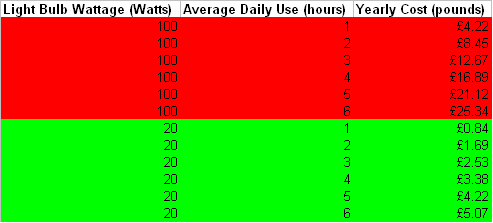Incandescent lights are out. No ifs, no buts. If you want to save energy and money they have got to go. Light is the byproduct of heating up the tungsten coil, which is why they are so inefficient.
See a comparison below of how much it costs to run a 100 watt tungsten light bulb versus how much it costs to run an equivalent CFL. (kWh @ 11.57 pence)

At the time of writing Tesco quotes £2.94 for a 20 W CFL, which means that even with an average use of one hour it is better to use a CFL. If you then take into account that CFLs can last 6000-15000 hours vs 1000-2000 hours for incandescent light bulbs, then the total cost of ownership is so high for incandescent light bulbs that it is simply a no brainer to use CFLs.
At an average of 4 hours a day and assuming 8000 hours lifetime, a CFL will cost you:
£21.52.
£18.58 in electricity + £2.94 to buy the CFL
Assuming a lifetime of 2000 hours for incandescent lights, 8000 hours will cost you:
£93.91.
£92.91 in electricity + 99p to buy a pack of four incandescent light bulbs
CFLs are not the panacea. They do contain mercury, so it is advisable not use them where kids can knock them down and break them. They also emit more UV light. This is only a concern if you are sensitive to UV light AND are very close to the CFL. On a more mundane level they don't work with dimmer switches and can take time to switch on.
I can't think of any real reason for using dimmer switches, so it is not a problem for me. If you have a hallway that you need to light quickly I suggest using Halogen lights, while they are in essence incandescent lights they are brighter (in lm/W terms) and therefore need less energy than normal incandescent lights.
The SI unit of luminous flux is the lumen, unfortunately the lumen is not a common day unit and unlike the kilogram or the metre it is hard to have a feel for what a lumen actually is. You can get an idea by looking at the graph below, linked from Wikipedia, that shows a plot of Power vs Luminous Flux. An incandescent light bulb (red line) has approximately 1250 lm @ 100 W, if you look at a 100 W incandescent light you are looking at approximately 1250 lumens of luminous flux. I don't expect that you will need to be able to estimate luminous flux of light bulbs by looking at them, but this should give you an idea of what a lumen, or 1250 lumen look like.

In order to get 1250 lm with a CFL ( green line) it takes approximately 18 W. It takes a Halogen light bulb approximately 40 W to reach 1250 lm.
No comments:
Post a Comment